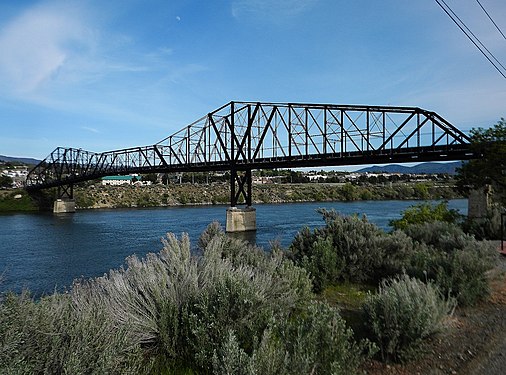Bridge in Washington / West Wenatchee, Washington
| Columbia River Bridge | |
|---|---|
 | |
| Coordinates | 47°24′53″N 120°17′50″W / 47.41461°N 120.29719°W / 47.41461; -120.29719 (Columbia River Bridge) |
| Crosses | Columbia River |
| Locale | East Wenatchee, Washington / West Wenatchee, Washington |
| Maintained by | Wenatchee Reclamation District, State of Washington |
| Characteristics | |
| Design | Pin-connected cantilever through truss |
| Total length | 1,600 feet (490 m) |
| Longest span | 520 feet (160 m) |
| Clearance below | 85 feet (26 m) |
| History | |
| Opened | 1908 |
| Replaces | Ferry |
| U.S. National Register of Historic Places | |
| Nearest city | Wenatchee, Washington |
| Area | less than one acre |
| Built by | Washington Bridge Company |
| MPS | Historic Bridges/Tunnels in Washington State TR |
| NRHP reference No. | 82004198 |
| Added to NRHP | July 16, 1982 |
| Location | |
The Columbia River Bridge at Wenatchee, Washington, also known as the Old Wenatchee Bridge and W.T. Clark Pipeline Bridge was built by the Washington Bridge Company in 1908, primarily as a means to carry irrigation water pipelines across the Columbia River. It was the first road bridge over the Columbia south of Canada. The bridge is a pin-connected cantilever truss, 1,600 feet (490 m) long, with one 200-foot (61 m) Pratt truss between two 160-foot (49 m) cantilever arms, with 240-foot (73 m) side arms and a 60 feet (18 m) girder span. The bridge was purchased by the Washington highway department for $182,000 for highway use. As originally built, the bridge carried a 20.5-foot (6.2 m) wide timber roadway, with additional ability to carry a street railway. However, the east approach to the bridge was built at a 6% grade, limiting its potential.
The bridge was replaced in 1950 by the Senator George Sellar Bridge. The next year the Wenatchee Reclamation District bought the bridge for $1.00, moving the pipes from outside the truss to within. The bridge was opened to foot traffic. In 2007 concerns were raised about the bridge's ability to sustain foot traffic. Repairs were made in 2010.
The bridge currently carries pedestrian and bicycle traffic as part of the Apple Capital Recreation Loop Trail. It was placed on the National Register of Historic Places on July 16, 1982. The bridge was renamed for irrigation canal builder William T. Clark in 2023.
References
- "HAER Inventory: Columbia River Bridge" (PDF). Historic American Engineering Record. Archived from the original (PDF) on March 29, 2012. Retrieved September 1, 2011.
- "National Register Information System". National Register of Historic Places. National Park Service. July 9, 2010.
- ^ Sherrard, Jean (November 28, 2024). "After 115 years, Wenatchee names its treasured cross-Columbia bridge". The Seattle Times. Archived from the original on November 28, 2024. Retrieved November 28, 2024.
- ^ "HAER Inventory: Columbia River Bridge" (PDF). Historic American Engineering Record. Archived from the original (PDF) on March 29, 2012. Retrieved September 1, 2011.
- "Pipeline bridge approaches its centennial". Wenatchee Business Journal. December 1, 2007.
- "Historic Pipeline/Pedestrian Bridge". Washington State Department of Transportation. Archived from the original on October 11, 2012. Retrieved September 1, 2011.
- "Nomination Form for Columbia River Bridge". National Park Service. and accompanying picture
| Crossings of the Columbia River | ||||
|---|---|---|---|---|
| ||||
- Road bridges on the National Register of Historic Places in Washington (state)
- Bridges completed in 1908
- Bridges in Chelan County, Washington
- Bridges in Douglas County, Washington
- Bridges over the Columbia River
- National Register of Historic Places in Chelan County, Washington
- 1908 establishments in Washington (state)
- Cantilever bridges in the United States
- Girder bridges in the United States
- Pratt truss bridges in the United States
- Metal bridges in the United States


